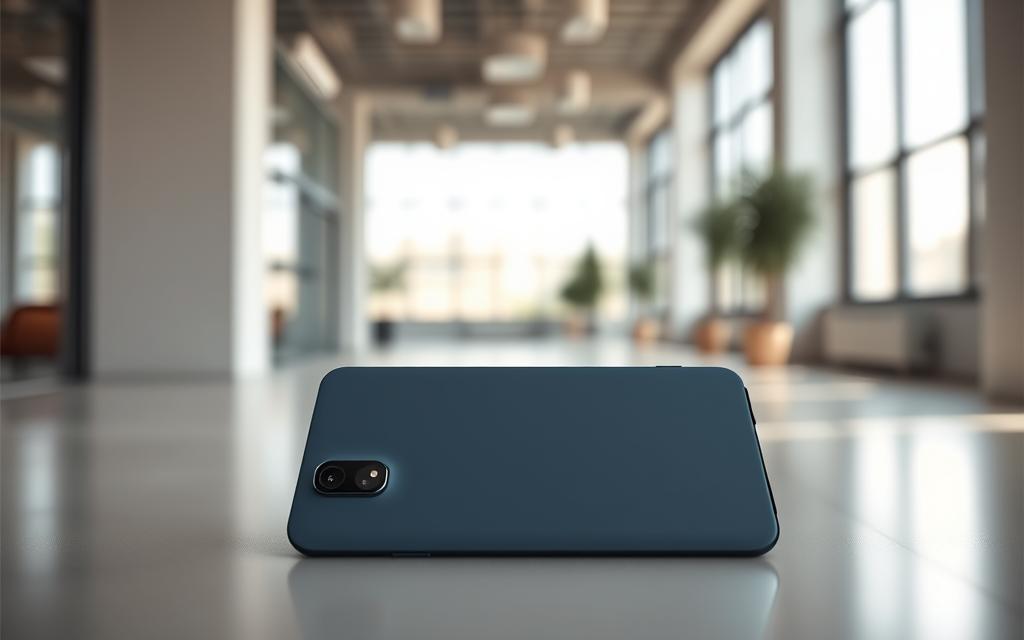Did you know that as of 2023, more than 85% of Americans have a smartphone? This shows how smartphones greatly changed life in the U.S. From the big mobile phones of the past to today’s slim, do-it-all devices, their journey is amazing.
Smartphone history shows big changes in how we talk and use tech. This led to major trends in the U.S. smartphone scene. Now, these changes affect not just how we connect but also how we find information and interact with others.
The Rise of Smartphones: A Brief History
Smartphones have become a key part of our lives. They started as a simple idea and grew into an essential tool. Initially, they were just for calls but now they serve many purposes.
The Introduction of the First Smartphones
The first smartphones appeared in the 1990s. IBM’s Simon, in 1994, was the first. It had a touchscreen and apps like a calendar and email.
Key Milestones in Smartphone Development
The journey of smartphones includes many important steps. The Motorola DynaTAC in 1983 was the first mobile phone sold. Then in the 1990s, 2G networks allowed for texting. A big change happened in 2007 when Apple released the iPhone. It made touchscreens and apps popular.
The Shift from Feature Phones to Smartphones
By the late 2000s, people wanted more from their phones. They preferred smartphones for their advanced features. This change led to a boom in smartphone sales. It also changed how people interact with technology.
Current Smartphone Market Landscape
The current smartphone market shows key trends in consumer actions and tech. It’s crucial to understand these trends to see how top smartphone brands and their operating systems are doing. Let’s look into the U.S. smartphone market shares, popular operating systems, and what consumers prefer in their smartphones.
Leading Brands and Their Market Shares
Apple, Samsung, and Google are big names in the smartphone world. Apple leads the U.S. market with its loyal customers and new features. Samsung is close behind, offering high-quality phones at various prices. Google’s Pixel phones stand out with their camera tech and software features.
| Brand | Market Share (%) |
|---|---|
| Apple | 50 |
| Samsung | 25 |
| 10 | |
| Others | 15 |
Popular Operating Systems in the U.S.
iOS and Android are the top operating systems. iOS is favored in high-end devices for its smooth ecosystem and security. Android supports many devices at different prices, appealing to a wide audience. Android’s ability to meet changing consumer needs makes it versatile.
Consumer Preferences and Trends
There’s a shift towards phones with better cameras, battery life, and connectivity. Features like 5G compatibility and strong software support are growing in interest. Brands are focusing on innovation to keep up with these demands. Knowing what consumers want helps brands stay competitive.
Impact of 5G Technology on Smartphones
The arrival of 5G tech is a huge leap in smartphone development. Users will find many benefits that make mobile use better. This includes crystal-clear streams and smooth online gaming. These changes make it worthwhile to switch to 5G-ready phones.
Benefits of 5G Connectivity for Users
The effect of 5G on phones is big. It brings faster data speeds, allowing quick downloads and smooth streaming. It also means less lag. This makes gaming and virtual reality better. Overall, 5G makes using various apps more enjoyable.
5G-Ready Devices: What to Expect
Big brands like Apple and Samsung have started using 5G in their new phones. For example, the iPhone 12 and Samsung Galaxy S20 are built to make the most of 5G. As 5G tech gets better, future phones will have even cooler features.
The Future of Network Speed and Smartphone Design
5G will change how future phones are made. We can expect longer battery life and smarter AI to boost performance. Phones will become more than just for talking. They will meet a wide range of needs, focusing on better connection and efficiency.
Design Trends in Modern Smartphones
The design of smartphones is changing fast, with new ideas reflecting what users want and need. We see foldable phones, minimalist designs, and eco-friendly materials becoming popular. These changes make phones more functional, stylish, and better for the environment.
The Move Towards Foldable Screens
People want bigger screens but still like their phones to be easy to carry. That’s why foldable phones are becoming more popular. The Samsung Galaxy Z Fold and Huawei Mate X show how a big screen can fit into a small space. This trend merges the best parts of smartphones and tablets for a smooth experience.
Minimalism and Aesthetics in Smartphone Design
Phone designs are becoming simpler and cleaner. Companies aim for a sleek look, removing unnecessary buttons and focusing on touch functions. Apple and Google are leaders in this, making devices that are easy and elegant to use. This simplicity helps users enjoy their phones without complication.
Sustainable Materials: Eco-Friendly Innovations
As more people care about the planet, the need for eco-friendly phones grows. Makers are using more recycled materials and looking into biodegradable options. Fairphone is a good example, with its focus on ethical sources and green production. By choosing these materials, companies appeal to eco-aware customers and help protect the environment.

| Design Trend | Key Features | Examples |
|---|---|---|
| Foldable Screens | Expandable display for multitasking | Samsung Galaxy Z Fold, Huawei Mate X |
| Minimalist Design | Sleek and simple aesthetics, fewer buttons | iPhone, Google Pixel |
| Eco-Friendly Materials | Recycled and sustainable materials | Fairphone, Apple’s recycled aluminum |
Camera Technology Advancements
Smartphones today have changed how we take pictures, thanks to big improvements in cameras. They now come with AI that lets users take amazing photos that used to need professional cameras. Every new update in smartphone cameras adds exciting features like multiple lenses, making photography more versatile and fun.
The Role of AI in Photography
AI has become super important in making smartphone photos better. It adjusts camera settings automatically, so your pictures look great without needing to know a lot about photography. With AI, you get cool effects like portrait mode which blurs the background and makes photos look more professional.
Features That Enhance User Experience
Today’s smartphones have features that really make taking photos better. Things like optical image stabilization keep pictures from getting blurry, especially in dim light. And with night mode, you can take great photos even in dark places. These features mean smartphones can now take photos as well as traditional cameras.
Trends in Multicamera Systems
The rise of multicamera systems in smartphones has changed photography. They offer wide-angle, telephoto, and macro lenses for all kinds of photos. Whether you’re taking photos for fun or professionally, these cameras give you lots of options. As camera tech gets better, we can’t wait to see what’s next.
| Feature | Benefit | User Impact |
|---|---|---|
| AI Optimization | Enhances image quality | Simplifies photo capture |
| Optical Image Stabilization | Reduces blurry images | Improves overall photo clarity |
| Multicamera Systems | Diverse photography options | Encourages creative exploration |
| Night Mode | Improves low-light photography | Expands shooting possibilities |
The Shift towards AI and Smart Features
AI and smartphones have completely changed mobile technology. They make interactions more intuitive and efficient. AI assistants like Siri and Alexa have broadened what smartphones can do. This progress brings big benefits, making everyday tasks much easier for us.
AI Assistants on Smartphones: A Game Changer
AI assistants have changed how we interact with our devices. They use natural language processing for easy communication. This means more satisfaction and efficiency in getting things done.
Personalized User Experiences through AI
AI analyzes data and watches how we behave to create personal experiences. It suggests things we might like. This makes using our devices more enjoyable and keeps us coming back.
Challenges and Concerns with AI Integration
Even with AI benefits, there are challenges. Privacy and data security are big concerns. People worry about relying too much on technology. Manufacturers need to be clear to build trust. Solving these problems is key for AI’s future.
Security Features and Privacy Trends
Smartphones have grown more advanced, alongside their smartphone security features. These features play a key role in guarding user data against privacy threats. Today, there’s a big push toward using biometric authentication to boost both security and how easily people can use their devices.
Importance of Biometrics in Smartphones
Biometric methods like fingerprint scans and face recognition are now very popular. They make it both safe and easy for users to get into their devices and see private info. The spread of these technologies shows a move to better smartphone security features, protecting personal details.
Encryption and Security Measures for Users
Encryption technology and strong security measures are now common in smartphones. They help keep data like texts, contacts, and financial info safe from outsiders. These steps are critical for data safety, showing how much protecting privacy matters today, especially with new privacy trends in phones.
Responding to Users’ Privacy Concerns
Data privacy worries have led to more open practices by companies. They are better at explaining their privacy rules and giving users control over their data. This is crucial for building users’ trust in mobile tech. It matches up with the newest privacy trends in smartphones.
| Feature | Advantages | Potential Risks |
|---|---|---|
| Fingerprint Scanners | Quick access, user-friendly | False acceptance, limited users |
| Facial Recognition | High security, non-intrusive | Mask spoofing, environmental factors |
| Encryption Technology | Data protection, privacy assurance | Performance impact, complexity |
The Role of Social Media and Apps in User Engagement
Social media and apps are key in how we use our smartphones. They mix communication, creativity, and socializing in exciting ways. These platforms have made a space where users enjoy sharing, connecting, and viewing content.
Must-Have Apps That Shape Smartphone Use
Instagram, Snapchat, and TikTok are vital for many. They offer cool visuals and fun content, boosting creativity and chat. Their growth shows how they change the way we share life and connect on our phones.
Social Media’s Influence on Purchase Decisions
Social media has a big say in what we buy. Brands use ads and influencers on these platforms to guide us to products. This influence reaches across our phone use, mixing socializing and shopping smoothly.
Trends in Mobile Gaming and Entertainment
The mobile gaming scene has grown with better graphics and play. Games like “Fortnite” and “Call of Duty: Mobile” highlight these changes. They show how phones have become not just for calls but also for great gaming, attracting millions.
The Future of Smartphones: What Lies Ahead?
We’re heading towards exciting times in smartphone tech. Soon, we’ll see big steps forward in how our phones work and connect. Look out for smarter artificial intelligence, better ways to stay connected, and long-lasting batteries. These updates will make smartphones more essential in our daily lives.
Predictions for Upcoming Technologies
Artificial intelligence will get even better, making our phones more helpful and personal. We’ll connect our smartphones with more devices easily, thanks to new tech. This will turn our phones into control centers for our gadgets at home and work.
The Integration of Augmented Reality
Augmented reality (AR) is set to change how we use our smartphones. Big companies are putting money into AR to create new experiences. This will make our smartphones even more powerful, mixing digital and real worlds in cool ways.
Evolving Consumer Needs and Their Impacts
People want their tech to be eco-friendly and well-connected. Makers of smartphones are listening. They’re working on greener ways to make phones and making sure they work with the latest tech. This keeps brands attractive to buyers who care about the planet and staying connected.




